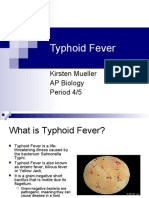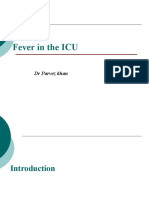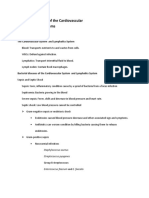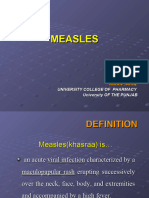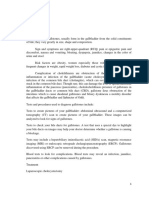Fever: Etiology
Fever: Etiology
Uploaded by
Czarina Mae JosonCopyright:
Available Formats
Fever: Etiology
Fever: Etiology
Uploaded by
Czarina Mae JosonOriginal Title
Copyright
Available Formats
Share this document
Did you find this document useful?
Is this content inappropriate?
Copyright:
Available Formats
Fever: Etiology
Fever: Etiology
Uploaded by
Czarina Mae JosonCopyright:
Available Formats
1
Fever
Fever is elevated body temperature (> 37.8° C orally or > 38.2° C rectally) or an
elevation above a person's known normal daily value by a resetting of the temperature
set point in the hypothalamus at higher value.
Hyperthermia: Elevated body temperature that is not caused by a resetting of the
temperature set point in the hypothalamus
During a 24-h period, temperature varies from lowest levels in the early morning to
highest in late afternoon. Maximum variation is about 0.6° C.
Consequences of fever
Modest transient core T ↑(ie, 38° to 40°) well tolerated by healthy adults-usually.
Extreme temperature elevation (typically > 41° C) may be damaging.
1. Organ failure; Protein denaturation occurs, and inflammatory cytokines that
activate the inflammatory cascade are released > cellular dysfunction >.
2. DIC < The coagulation cascade is also activated.
3. Physiologically stress adults with pre-existing cardiac or pulmonary
insufficiency.( fever can ↑ BMR by ~10 to 12% for every 1° C ↑ over 37° C)
4. Worsen mental status in patients with dementia.
5. Febrile seizures in children.
Etiology
Many disorders can cause fever. They are broadly categorized as
1. Infectious (most common)
2. Neoplastic
3. Inflammatory (including rheumatic, nonrheumatic, and drug-related)
Acute (ie, duration ≤ 4 days) fever in adults is highly likely to be infectious.
Fever due to a noninfectious cause, the fever is almost always chronic or recurrent.
Isolated, acute febrile event in patients with a known inflammatory or neoplastic
disorder is still most likely to be infectious.
Commonly
1. Upper and lower respiratory tract infections
2. GI infections
3. UTIs
4. Skin infections
Most acute respiratory tract and GI infections are viral.
Patient factors include health status, age, occupation, and risk factors (eg,
hospitalization, recent invasive procedures, presence of IV or urinary catheters, use of
mechanical ventilation).
Yapa Wijeratne Merck Manual
2
External factors are those that expose patients to specific diseases—eg, through
infected contacts, local outbreaks, disease vectors (eg, mosquitoes, ticks), a common
vehicle (eg, food, water), or geographic location (eg, residence in or recent travel to
an endemic area).
Some Causes of Acute Fever
Predisposing Factor Cause
None (healthy) Upper or lower respiratory tract infection
GI infection
UTI
Skin infection
Hospitalization IV catheter infection
UTI (particularly in patients with an indwelling catheter)
Pneumonia (particularly in patients using a ventilator)
Atelectasis
Surgical site infection (postoperatively)
Deep venous thrombosis or pulmonary embolism
Diarrhea (Clostridium difficile–induced)
Drugs
Hematoma
Transfusion reaction
Decubitus ulcers
Travel to endemic Malaria
areas Viral hepatitis
Diarrheal disorders
Typhoid fever
Dengue fever (less common)
Vector exposure (in Ticks: Rickettsiosis, ehrlichiosis, anaplasmosis, Lyme disease,
US) babesiosis, tularemia
Mosquitoes: Arboviral encephalitis
Wild animals: Tularemia, rabies, hantavirus infection
Fleas: Plague
Domestic animals: Brucellosis, cat-scratch disease, Q fever,
toxoplasmosis
Birds: Psittacosis
Reptiles: Salmonella infection
Bats: Rabies, histoplasmosis
Immunocompromise Viruses: VZV or CMV infection
Bacteria: Infection due to encapsulated organisms (eg,
pneumococcus, meningococcus), Staphylococcus aureus,
gram-negative bacteria (eg, Pseudomonas aeruginosa),
Nocardia sp, or Mycobacteria sp
Fungi: Infection due to Candida, Aspergillus, Zygomycetes,
Histoplasma, or Coccidioides sp or Pneumocystis jirovecii
Parasites: Infection due to Toxoplasma gondii, Strongyloides
stercoralis, Cryptosporidium sp, microsporidia, or
Yapa Wijeratne Merck Manual
3
Cystoisospora (previously Isospora) belli
Drugs that can Amphetamines
increase heat Cocaine
production MDMA, or Ecstasy
Antipsychotics
Anesthetics
Drugs that can β-Lactam antibiotics
trigger a Sulfa drugs
hypersensitivity Phenytoin
reaction Carbamazepine
Procainamide
Quinidine
Amphotericin B
Interferons
Evaluation
History
History of present illness should cover
o Magnitude of fever
o Duration of fever
o Method used to take the temperature.
1.True rigors (severe, shaking, teeth-chattering chills—not simply feeling cold)
suggest fever due to infection but are not otherwise specific.
2. Pain; in the ears, head, joints etc.
3. Other localizing symptoms; nasal congestion and/or discharge, cough, diarrhea, &
urinary symptoms (frequency, urgency, dysuria).
4. Rash (including nature, location, and time of onset in relation to other symptoms)
and Lymphadenopathy.
5. Infected contacts and their diagnosis should be identified.
Review of systems
Symptoms of chronic illness; recurrent fevers, night sweats, and weight loss.
Past medical history
1. Recent surgery
2. Known disorders that predispose to infection (eg, HIV infection, diabetes, cancer,
organ transplantation, sickle cell disease, valvular heart disorders—particularly if an
artificial valve is present)
3. Known disorders that predispose to fever (eg, rheumatologic disorders, SLE, gout,
sarcoidosis, hyperthyroidism, cancer)
4. Recent travel include location, time since return, locale (eg, in back country, only
in cities), vaccinations received before travel, and any use of prophylactic antimalarial
drugs (if required).
5. Possible exposures (eg, via unsafe food or water, insect bites, animal contact, or
unprotected sex).
6. Vaccination; hepatitis A and B and against organisms that cause meningitis,
Yapa Wijeratne Merck Manual
4
influenza, or pneumococcal infection
Drugs
1. Known to cause fever
2. Predispose to infection (eg, corticosteroids, anti-TNF drugs, chemotherapeutic and
antirejection drugs, other immunosuppressants)
3.Illicit use of injection drugs (predisposing to endocarditis, hepatitis, septic
pulmonary emboli, and skin and soft-tissue infections)
Performance of the various types of fever
a) Fever continues
b) Fever continues to abrupt onset and remission
c) Fever remittent
d) intermittent fever
e) undulant fever
f) Relapsing fever
Continuous fever
Do not fluctuate more than 1oc during 24 hours but no time touching the base line
Remittent Fever
Fluctuation exceeds 2oc but do not touches the base line
Eg-
1. Amoebiasis
2. Salmonella
3. TB
4. Kawasaki's disease
Continuous undulating fever
eg- Typhoid, Brucellosis
Intermittent Fever
Fever only present for few hours.
Daily fever spikes- abscess, pneumonia etc
Tertian fever-(Alternate days)- P.vivax, P. falciparum
Quartan fever-(Every 3rd day) –P.malariae
Saddle back fever-(fever for some days and then normal for few days and again fever)
eg- leptospirosis, Borrelia
Pel-Ebstein fever – (long periods of normal or low temperature)
eg- Hodgkin’s lymphomas, other lymphomas
Step Ladder Type Fever
Fever increases as step ladder type fashion.
Eg- Typhoid fever
Fever With Chills & Rigors
1. Malaria
2. UTI- Pyelonephritis
Yapa Wijeratne Merck Manual
5
3. Cholecystitis/ ascending cholangitis
4. Pneumonia
5. Abscess
Low Grade Fevers
Chronic inflammatory conditions and in malignancies
Eg- TB
Sarcoidosis
Physical examination
A/febrile
Fever is most accurately diagnosed by measuring rectal temperature. Oral temperatures are normally about 0.6° C lower and may
be falsely even lower for many reasons, such as recent ingestion of a cold drink, mouth breathing, hyperventilation, and
inadequate measurement time (up to several minutes are required with mercury thermometers). Measurement of tympanic
membrane temperature by infrared sensor is less accurate than rectal temperature.
Tachypnea, tachycardia, or hypotension.
General appearance; any weakness, lethargy, confusion, cachexia, and distress.
Skin rash,
particularly petechial or hemorrhagic rash and any lesions or areas of erythema or
blistering suggesting skin or soft-tissue infection.
Lymphadenopathy; Axillae and epitrochlear and inguinal
In hospitalized patients, presence of any IVs, NGTs, urinary catheters..Etc.
Surgical sites If any recent Sx.
Head and neck examination
Tympanic membranes: Examined for infection
Sinuses (frontal and maxillary): Percussed
Temporal arteries: tenderness
Nose: Inspected for congestion and discharge (clear or purulent)
Eyes: conjunctivitis or icterus
Fundi: Roth's spots (suggesting endocarditis)
Oropharynx and gingiva: inflammation or ulceration (including any lesions of
candidiasis, which suggests immunocompromise)
Neck: meningismus, lymphadenopathy
The lungs; crackles or signs of consolidation, and the heart; murmurs (IE).
The abdomen; hepatosplenomegaly and tenderness (infection).
The flanks are percussed for tenderness over the kidneys (pyelonephritis).
A pelvic examination ♀ cervical motion or adnexal tenderness;
♂ genital : urethral discharge and local tenderness.
The rectum; tenderness and swelling > perirectal abscess (which may be occult in
immunosuppressed patients).
Yapa Wijeratne Merck Manual
6
All major joints are examined for swelling, erythema, and tenderness (suggesting a
joint infection or rheumatologic disorder).
The hands and feet; for signs of endocarditis, splinter haemorrhages/Osler's
nodes/Janeway lesions.
Red flags
The following findings are of particular concern:
Altered mental status
Headache, stiff neck, or both
Petechial skin rash
Hypotension
Significant tachycardia or tachypnea
Temperature > 40° C or < 35° C
Recent travel to malaria-endemic area
Recent use of immunosuppressants
Headache, stiff neck, and petechial or purpuric rash > meningitis.
Tachycardia, tachypnea, with or without hypotension or mental status changes >
sepsis.
Malaria > traveled to an endemic area.
Generalized adenopathy may occur in older children and younger adults who have
acute mononucleosis; it is usually accompanied by significant pharyngitis, malaise,
and hepatosplenomegaly.
Primary HIV/ secondary syphilis should be suspected in patients with generalized
adenopathy, sometimes accompanied by arthralgias, rash, or both.
HIV infection develops 2 to 6 wk after exposure (although patients may not always report unprotected sexual
contact or other risk factors).
Secondary syphilis is usually preceded by a chancre, with systemic symptoms developing 4 to 10 wk later.
Petechial or purpuric rash > meningococcemia, DF, DHF, Rocky Mountain spotted
fever (particularly if the palms or soles are involved).
Classic erythema migrans rash of Lyme disease, target lesions of Stevens-Johnson
syndrome, and the painful, tender erythema of cellulitis and other bacterial soft-tissue
infections. The possibility of delayed drug hypersensitivity (even after long periods of
use)
Patients with significant underlying disorders are more likely to have an occult
bacterial or parasitic infection. Injection drug users and patients with a prosthetic
heart valve > endocarditis.
Drug fever (with or without rash) is a diagnosis of exclusion, often requiring a trial of
stopping the drug. Eg. fever and rash begin after clinical improvement from the initial infection and without worsening
or reappearance of the original symptoms (eg, in a patient being treated for pneumonia, fever reappears without cough, dyspnea,
or hypoxia).
Testing
Mononucleosis or HIV infection: Serologic testing
Bacterial or fungal infection: Blood cultures
Yapa Wijeratne Merck Manual
7
Meningitis: Immediate LP & IV antibiotics (head CT should be done before LP if
patients are at risk of brain herniation; IV antibiotics must be given immediately after
blood cultures are obtained and before head CT is done)
Specific disorders based on exposure (eg, to contacts, to vectors, or in endemic areas):
peripheral blood smear for malaria
Sepsis > cultures (urine and blood), CXR, SE, glucose, BUN, creatinine, lactate, &
liver enzymes.
Risk groups of IE; serial blood cultures, ECHO
Patients taking immunosuppressants require FBC; if neutropenia is present, testing is
initiated and CXR, as are cultures of blood, sputum, urine, stool, and any suspicious
skin lesions.
Treatment
1. Drugs that inhibit brain cyclooxygenase effectively reduce fever:
PCM 650-1000 mg po q 6 h
Ibuprofen 400-600 mg po q 6 h
The daily dose of PCM should not exceed 4 g to avoid toxicity; patients should be
warned not to simultaneously take nonprescription cold or flu remedies that contain
PCM. Other NSAIDs (eg, aspirin, naproxen) are also effective antipyretics.
Salicylates should not be used to treat fever in children with viral illnesses (Reye's
syndrome.)
2. Antibiotics
3. If temperature is ≥ 41° C, start other cooling measures (eg, evaporative cooling
with tepid water mist, cooling blankets).
Geriatrics Essentials
In the frail elderly, infection is less likely to cause fever, and even when elevated by
infection, temperature may be lower than the standard definition of fever. Similarly,
other inflammatory symptoms, such as focal pain, may be less prominent.
Frequently, alteration of mental status or decline in daily functioning may be the only
other initial manifestations of pneumonia or UTI.
As in younger adults, the cause is commonly a respiratory infection or UTI, but in the
elderly, skin and soft-tissue infections are among the top causes.
Ix: urinalysis, urine culture, CXR. Blood cultures should be done to exclude
septicaemia.
Yapa Wijeratne Merck Manual
You might also like
- Complete Answer Guide for Australasian Business Statistics 4th Edition black Test Bank100% (7)Complete Answer Guide for Australasian Business Statistics 4th Edition black Test Bank42 pages
- Approach To The Febrile Patient: Dr.P.V.Balamurugan, M.D Senior Assistant Professor Dept. of Medicine GTMCH, TheniNo ratings yetApproach To The Febrile Patient: Dr.P.V.Balamurugan, M.D Senior Assistant Professor Dept. of Medicine GTMCH, Theni85 pages
- Week 13 - Respiratory Disease, Continued.No ratings yetWeek 13 - Respiratory Disease, Continued.16 pages
- Leptospirosis, Typhoid and Other FeversNo ratings yetLeptospirosis, Typhoid and Other Fevers37 pages
- Biological Warfare: Renaat A. A. M. Peleman, MD, PHD Dept Internal Med, Div Infect Dis University Hospital GhentNo ratings yetBiological Warfare: Renaat A. A. M. Peleman, MD, PHD Dept Internal Med, Div Infect Dis University Hospital Ghent63 pages
- fever DrAFaq naeem lecture notes_240707_234349No ratings yetfever DrAFaq naeem lecture notes_240707_2343493 pages
- Conjunction With An Increase in The Hypothalamic Set Point (E.g., From 37°C To 39°CNo ratings yetConjunction With An Increase in The Hypothalamic Set Point (E.g., From 37°C To 39°C4 pages
- Evaluation of The Febrile Patient A Case-Based Approach: Fevers and Fevers of Unknown OriginNo ratings yetEvaluation of The Febrile Patient A Case-Based Approach: Fevers and Fevers of Unknown Origin97 pages
- Typhoid Fever: Kirsten Mueller AP Biology Period 4/5No ratings yetTyphoid Fever: Kirsten Mueller AP Biology Period 4/548 pages
- Clinical Approach in Children With FeverNo ratings yetClinical Approach in Children With Fever44 pages
- Microbial Diseases of The CardiovascularNo ratings yetMicrobial Diseases of The Cardiovascular5 pages
- Clinical Presentation of Infectious Diseases and PUONo ratings yetClinical Presentation of Infectious Diseases and PUO24 pages
- K17. Parasit Yang Menyebabkan Infeksi OtakNo ratings yetK17. Parasit Yang Menyebabkan Infeksi Otak71 pages
- Muhammad Usman Akram: (DVM Student at Rcvets Lahore)100% (1)Muhammad Usman Akram: (DVM Student at Rcvets Lahore)29 pages
- Concept of Prevention, Level of PreventionNo ratings yetConcept of Prevention, Level of Prevention45 pages
- Applied Nursing Research: Mi-Kyoung Cho, PHD, Apn, Gisoo Shin, PHD, RNNo ratings yetApplied Nursing Research: Mi-Kyoung Cho, PHD, Apn, Gisoo Shin, PHD, RN7 pages
- Final Theoretical Exam in Pediatrics " Set A ": Choose The Most Appropriate ResponseNo ratings yetFinal Theoretical Exam in Pediatrics " Set A ": Choose The Most Appropriate Response54 pages
- The Use of Radioactive Elements in MedicineNo ratings yetThe Use of Radioactive Elements in Medicine5 pages
- Rehabilitation: I Type Tasks. Choose Only One Best AnswerNo ratings yetRehabilitation: I Type Tasks. Choose Only One Best Answer6 pages
- Classification of Drugs Are: Hepatoprotective Drugs E.g.: Silymarin Antibiotics E.G.No ratings yetClassification of Drugs Are: Hepatoprotective Drugs E.g.: Silymarin Antibiotics E.G.2 pages
- WHS AP Psychology: Unit 11: Mental Illness and TherapiesNo ratings yetWHS AP Psychology: Unit 11: Mental Illness and Therapies22 pages
- S53 - Syed Kashif Ghani-Fpsc Zakir Nagar: Patientreportscsuperpanel - General - Panel - Analyte - SC (Version: 6)No ratings yetS53 - Syed Kashif Ghani-Fpsc Zakir Nagar: Patientreportscsuperpanel - General - Panel - Analyte - SC (Version: 6)11 pages
- Complete Answer Guide for Australasian Business Statistics 4th Edition black Test BankComplete Answer Guide for Australasian Business Statistics 4th Edition black Test Bank
- Approach To The Febrile Patient: Dr.P.V.Balamurugan, M.D Senior Assistant Professor Dept. of Medicine GTMCH, TheniApproach To The Febrile Patient: Dr.P.V.Balamurugan, M.D Senior Assistant Professor Dept. of Medicine GTMCH, Theni
- Biological Warfare: Renaat A. A. M. Peleman, MD, PHD Dept Internal Med, Div Infect Dis University Hospital GhentBiological Warfare: Renaat A. A. M. Peleman, MD, PHD Dept Internal Med, Div Infect Dis University Hospital Ghent
- Conjunction With An Increase in The Hypothalamic Set Point (E.g., From 37°C To 39°CConjunction With An Increase in The Hypothalamic Set Point (E.g., From 37°C To 39°C
- Evaluation of The Febrile Patient A Case-Based Approach: Fevers and Fevers of Unknown OriginEvaluation of The Febrile Patient A Case-Based Approach: Fevers and Fevers of Unknown Origin
- Typhoid Fever: Kirsten Mueller AP Biology Period 4/5Typhoid Fever: Kirsten Mueller AP Biology Period 4/5
- Clinical Presentation of Infectious Diseases and PUOClinical Presentation of Infectious Diseases and PUO
- Muhammad Usman Akram: (DVM Student at Rcvets Lahore)Muhammad Usman Akram: (DVM Student at Rcvets Lahore)
- The Flu: A Guide for Prevention and TreatmentFrom EverandThe Flu: A Guide for Prevention and Treatment
- Applied Nursing Research: Mi-Kyoung Cho, PHD, Apn, Gisoo Shin, PHD, RNApplied Nursing Research: Mi-Kyoung Cho, PHD, Apn, Gisoo Shin, PHD, RN
- Final Theoretical Exam in Pediatrics " Set A ": Choose The Most Appropriate ResponseFinal Theoretical Exam in Pediatrics " Set A ": Choose The Most Appropriate Response
- Rehabilitation: I Type Tasks. Choose Only One Best AnswerRehabilitation: I Type Tasks. Choose Only One Best Answer
- Classification of Drugs Are: Hepatoprotective Drugs E.g.: Silymarin Antibiotics E.G.Classification of Drugs Are: Hepatoprotective Drugs E.g.: Silymarin Antibiotics E.G.
- WHS AP Psychology: Unit 11: Mental Illness and TherapiesWHS AP Psychology: Unit 11: Mental Illness and Therapies
- S53 - Syed Kashif Ghani-Fpsc Zakir Nagar: Patientreportscsuperpanel - General - Panel - Analyte - SC (Version: 6)S53 - Syed Kashif Ghani-Fpsc Zakir Nagar: Patientreportscsuperpanel - General - Panel - Analyte - SC (Version: 6)




















